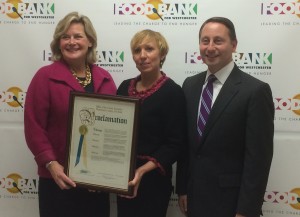Food Bank for Westchester, hunger coalition join forces
Hoping to streamline and strengthen their charitable efforts, two of Westchester”™s major charities that focus on feeding the hungry have merged.
Officials with the Food Bank for Westchester and the Westchester Coalition for the Hungry and Homeless Inc. signed an agreement merging the nonprofit organizations Friday at a ceremony at Food Bank headquarters in Elmsford. The agency, which was founded in 1988, is one of eight regional food banks in New York state and provides about 6.1 million meals to the hungry in Westchester County each year, according to Food Bank Executive Director Ellen Lynch.
“In Westchester in particular, it”™s really easy to deny (that people deal with hunger),” Lynch said. The 6 million meals per year only cover about 40 percent of the meals needed to feed the hungry in the county, she said. “The overall gap, after government assistance, is about 15.1 million meals, so we”™ve got a ways to go.”

- From left, Ellen Lynch, executive director of the Food Bank for Westchester; Jeanne Blum, Food Bank vice president of strategic partnerships and advocacy, and former executive director of the Westchester Coalition for the Hungry and Homeless; and Westchester County Executive Robert P. Astorino. Photo by Leif Skodnick
The Westchester Coalition for the Hungry and Homeless, also formed in 1988, is moving its operations to Food Bank headquarters. The coalition consists of 141 food providers throughout the county directly serving residents, including 72 food pantries, 38 soup kitchens and 31 shelters, according to its website. Its activities include advocating for hunger relief, and working to obtain financial support for programs and providing technical support.
“We”™re now going to be able to accomplish our missions collectively, to create the economies of scale, make a greater impact, and be more efficient in everything we do from gathering food to rallying community partners and galvanizing people around the county to look at the need and address it,” Jeanne Blum, former executive director of the coalition, told the Business Journal following the ceremony. Blum will serve as vice president of strategic partnerships and advocacy for the Food Bank for Westchester.
“My role as an advocate for strategic partnerships will enable us to build our capacity so that we can push for policy change and get more of our government leaders on board with us,” Blum said.
As government budgets for social services that help those in need continue to be cut, nonprofit organizations will have to do more to fill the gap ”“ which, for the hungry in Westchester County, amounts to about 9 million meals a year.
“The taxpayers that make government happen don”™t have the wherewithal to just give money out to every well-intentioned organization and well-intentioned idea,” said Westchester County Executive Robert P. Astorino.
“The shrinking government dollars that go out to nonprofits for their efforts, that was a key driver behind the merger,” Blum said. “Why have two operating budgets? Combine it so that we can feed more people, so that we can address the issue.”
Rick Rakow, chairman of the Food Bank’s board of directors, said the cost savings of the merger will be significant.
“The resources that the county is making available to this merged organization will allow us to serve everybody in our community so much better,” Rakow said at the ceremony. “The funds that were previously dedicated to things like administrative costs are now going to come in and allow us to purchase what”™s going to average out to 250,000 meals.”
Lynch said the Food Bank”™s 2012 move into the Elmsford distribution center, a 37,000-square-foot facility with the county”™s largest refrigerator and freezer, has helped the organization provide more food to the nearly 200,000 Westchester residents who are in need over the past few years.
“When you get offered a bulk donation, you have to put it somewhere,” Lynch said, using the example of a truckload of frozen chicken. “If we have to sit around trying to find someone to split the truckload with us because we have no place to put it, by the time we find that guy, the chicken”™s gone.”
“Now we can take those big donations when the opportunities come up,” she said. “You have to be able to take the help. We want to do more and more of that, and leverage the resources that are available, and with the coalition joining us, we have more time and more ability to focus on that.”
Winter is the toughest season for the hungry, Lynch said, due to seasonal employment losses, higher utility bills and the holidays, which create financial issues that often put people at risk of hunger. Another measure of need, Lynch said that 25,000 school children in Westchester County get free or reduced-price lunch every day.
Blum and Lynch, having joined forces, hope to see that number, along with the 15.1 million meals needed annually to feed Westchester”™s hungry, drop significantly.
“We live in one of the most affluent counties in America,” Blum said. “We need to make people aware that poverty and hunger exist in Westchester County and can”™t go unnoticed.”